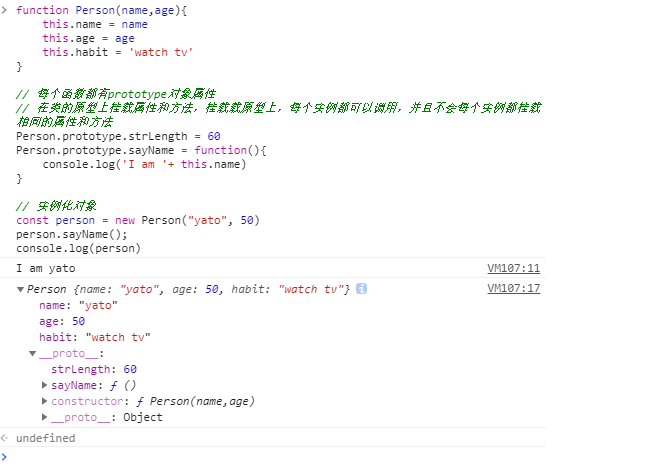模拟实现js的new
new是什么
一句话介绍new :new运算符创建一个用户自定义的对象类型的实例,或者具有构造函数的内置对象类型之一。看下下面的代码来了解new操作符都做了什么事情
// Class (constructor)
function Person(name,age){
this.name = name
this.age = age
this.habit = 'watch tv'
}
// 每个函数都有prototype对象属性
// 在类的原型上挂载属性和方法,挂载载原型上,每个实例都可以调用,并且不会每个实例都挂载相同的属性和方法
Person.prototype.strLength = 60
Person.prototype.sayName = function(){
console.log('I am '+ this.name)
}
// 实例化对象
const person = new Person("yato", 50)
person.sayName();
console.log(person)

进一步理解new
从上面这个例子中,我们可以看到,实例person可以
- 访问到Person构造函数里的属性
- 访问到Person.prototype中的属性
接下来模拟实现一个类似new的newFake,使用方式如下
function Person(arguments){
// ...
}
// 使用new
let person = new Person(arguments)
// 使用newFake
let person = newFake(Person,arguments)
初步实现
function newFake(){
let obj = Object.create({})
let Constructor = [].shift.call(arguments)
if(typeof Constructor !== 'function'){
throw 'newOperator function the first param must be a function';
}
// 将新建对象的[[prototype]]属性指向到构造函数的prototype属性
obj.__proto__ = Constructor.prototype
// 修改this指向到obj
Constructor.apply(obj, arguments)
return obj
}
function Person(name,age){
this.name = name
this.age = age
this.habit = 'watch tv'
}
// 每个函数都有prototype对象属性
// 在类的原型上挂载属性和方法,挂载载原型上,每个实例都可以调用,并且不会每个实例都挂载相同的属性和方法
Person.prototype.strLength = 60
Person.prototype.sayName = function(){
console.log('I am '+ this.name)
}
// 实例化对象
const person = newFake(Person,"yato", 50)
person.sayName(); // I am yato
console.log(person) // Person { name: 'yato', age: 50, habit: 'watch tv' }
返回值处理
如果构造函数有返回值的情况
function Person(name,age){
this.strLength = 60
this.age = age
return {
name: name,
habit: 'game'
}
}
let person = new Person('yato', 18)
console.log(person.name) // yato
console.log(person.habit) // game
console.log(person.strength) // undefined
console.log(person.age) // undefined
在这个例子中,构造函数返回了一个对象,在实例person中只能访问返回对象中的属性,而且还要注意一点,这里我们是返回一个对象,假设我们只返回一个基本类型值呢,看下面的例子
function Person(name,age){
this.strLength = 60
this.age = age
return 'good job'
}
let person = new Person('yato', 18)
console.log(person.name) // undefined
console.log(person.habit) // undefined
console.log(person.strength) // 60
console.log(person.age) // 18
结果和正常new实例,无返回值的时候表现是一样的!可以得出结论:new操作最后一步,需要判断一返回值是否是一个对象,如果是一个对象就返回这个对象,如果不是对象就返回我们new内部的实例对象
第二版的new实现
function newFake(){
let obj = Object.create({})
let Constructor = [].shift.call(arguments)
if(typeof Constructor !== 'function'){
throw 'newOperator function the first param must be a function';
}
// ES6 new.target 是指向构造函数
newFake.target = Constructor;
// 将新建对象的[[prototype]]属性指向到构造函数的prototype属性
obj.__proto__ = Constructor.prototype
// 修改this指向到obj
let ret = Constructor.apply(obj, arguments)
// 判断返回值是否为对象 Object(包含Functoin, Array, Date, RegExg, Error)都会直接返回这些值。
// 这些类型中合并起来只有Object和Function两种类型 typeof null 也是'object'所以要不等于null,排除 // null
let isObject = typeof ret === 'object' && ret !== null;
let isFunction = typeof ret === 'function';
if(isObject || isFunction){
return ret;
}
return obj
}
总结一下new做了什么
- 创建了一个全新的对象
- 这个对象会被执行实例[[prototype]]属性到Class的
prototype对象属性的链接(原型链) - 生成的新对象会成为构造函数的调用的this(修改this指向)
- 通过new创建的每个实例对象最终将被[[prototype]]链接到构造函数的prototype对象上
- 如果函数没有返回对象类型(包含
Function,Array,Date,RegExg,Error),那么new表达式中的函数会自动返回这个新的对象


 浙公网安备 33010602011771号
浙公网安备 33010602011771号